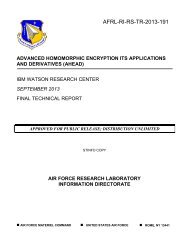EN100-web
EN100-web
EN100-web
Create successful ePaper yourself
Turn your PDF publications into a flip-book with our unique Google optimized e-Paper software.
Special theme: Scientific Data Sharing and Re-use<br />
Metadata Assisted Canonical Brokering:<br />
The next step has canonical metadata<br />
outside the conversion software with<br />
which the metadata of any dataset of<br />
interest is matched/mapped. Again, the<br />
kinds of tools mentioned above are used.<br />
This reduces the n*(n-1) problem to n.<br />
However, a canonical metadata scheme<br />
for all datasets is a huge superset.<br />
Restricting the canonical metadata<br />
(based on commonality among<br />
entities/attributes) to that required for<br />
contextualisation (of which discovery is<br />
a subset) maintains the benefits of the<br />
reduction from n*(n-1) to n for much of<br />
the processing and only when connecting<br />
data to software with detailed,<br />
domain-specific schemas is it necessary<br />
to write or generate specific software.<br />
Metadata Assisted Canonical Brokering<br />
at Domain Level: The above technique<br />
for contextual metadata may be applied<br />
at detailed level restricted to a domain.<br />
This is not applicable for multidisciplinary<br />
interoperation. In any particular<br />
domain there is considerable commonality<br />
among entities/attributes e.g. in<br />
environmental sciences many datasets<br />
have geospatial and temporal coordinates<br />
and time-series data have similar<br />
attributes (e.g. temperature and salinity<br />
from ocean sensors).<br />
The advantage of Metadata<br />
The use of metadata and associated<br />
matching/mapping in brokering either<br />
provides a specification for the programmer<br />
writing or generates or partially<br />
generates the mediating software.<br />
Data interoperability – researched intensively<br />
since the 1970s – remains without<br />
automated processes. Partial automation,<br />
based on contextual metadata has<br />
reduced considerably the cost and time<br />
required to provide interoperability.<br />
Metadata Assisted Brokering in RDA<br />
Metadata is omnipresent in RDA activities;<br />
four groups specialise in metadata<br />
as mentioned in an accompanying<br />
article. These groups are now working<br />
closely with the Brokering Governance<br />
WG (https://rd-alliance.org/groups/brokering-governance.html)<br />
to promote<br />
techniques for dataset interoperation.<br />
Link:<br />
https://rd-alliance.org/groups/<br />
brokering-governance.html<br />
References:<br />
[1] S. Nativi, M. Craglia, J. Pearlman:<br />
“Earth Science Infrastructures<br />
Interoperability: The Brokering<br />
Approach”, IEEE JSTARS, Vol. 6 N.<br />
3, pp. 1118-1129, 2013.<br />
[2] M. J. Franklin, A. Y. Halevy, D.<br />
Maier: “A first tutorial on dataspaces”,<br />
PVLDB 1(2): 1516-1517 (2008).<br />
http://www.vldb.org/pvldb/1/1454217.pdf<br />
[3] K. Skoupy, J. Kohoutkova, M.<br />
Benesovsky, K.G. Jeffery:<br />
“‘Hypermedata Approach: A Way to<br />
Systems Integration”, in proc. of<br />
ADBIS’99, Maribor, Slovenia, 1999,<br />
ISBN 86-435-0285-5, pp 9-15.<br />
Please contact:<br />
Stefano Nativi<br />
CNR, Italy<br />
E-mail: stefano.nativi@cnr.it<br />
Asking the Right Questions - Query-Based Data<br />
Citation to Precisely Identify Subsets of Data<br />
by Stefan Pröll and Andreas Rauber<br />
Data underpins most scientific endeavours. However, the question of how to enable scalable and<br />
precise citation of arbitrary subsets of static and specifically dynamic data still constitutes a nontrivial<br />
challenge.<br />
Although data has been the source of<br />
new knowledge for centuries, it has<br />
never received the same attention as the<br />
publications about the derived discoveries.<br />
Only recently has it been recognized<br />
as a first-class citizen in science,<br />
earning equal merit (see Link JDDCP<br />
below). Beyond mere referencing for the<br />
purpose of acknowledging the creators,<br />
it is the underlying basis and evidence<br />
for many scientific discoveries. With the<br />
increasing focus on repeatability and<br />
verifyability in the experimental sciences,<br />
providing access to the underlying<br />
data is becoming essential.<br />
Data used to be condensed into human<br />
readable form, by aggregating source<br />
data into tables and graphs.<br />
Alternatively, the specific subset and<br />
version of data used in a study was<br />
deposited in a repository for later reuse.<br />
With the arrival of data driven science<br />
[1], the increasing amount of data<br />
processed and the increasing dynamics<br />
of data, these conventional approaches<br />
are no longer scalable.<br />
Research datasets can be huge in terms<br />
of contained records. Scientists are<br />
often interested in a particular view of<br />
their data, using subsets tailored to a<br />
specific research question. An experiment<br />
can only be reproduced and verified<br />
if the same subset can be retrieved<br />
later. Depositing the specific subset in a<br />
repository does not scale to big data settings.<br />
Also providing the metadata<br />
helping users to find, interpet and<br />
access specific datasets again can be a<br />
challenge. Textual descriptions of subsets<br />
are hardly precise enough, require<br />
human intervention and interpretation<br />
of ambiguous descriptions in re-creating<br />
the dataset, limiting reproducibility<br />
of experiments and re-use in<br />
meta-studies.<br />
Furthermore, many research datasets<br />
are highly dynamic: new data is added<br />
continuously via data stream, rendering<br />
conventional versioning approaches<br />
useless unless one wants to revert to<br />
old-fashioned time-delayed batch<br />
releases of annual/quarterly versions of<br />
the data. Additional dynamics arise<br />
from the need to correct errors in the<br />
data, removing erroneous data values,<br />
or re-calibrating and thus re-computing<br />
values at later points in time. Thus,<br />
researchers require a mechanism to<br />
retrieve a specific state of the data<br />
again, in order to compare the results of<br />
26<br />
ERCIM NEWS 100 January 2015



